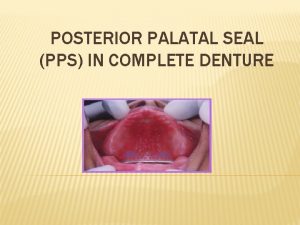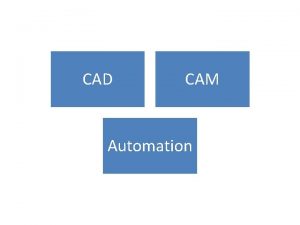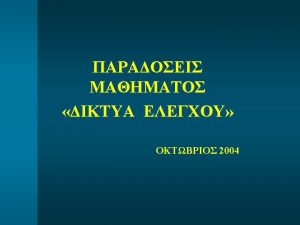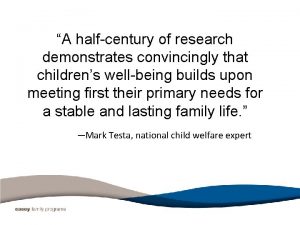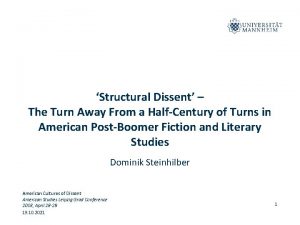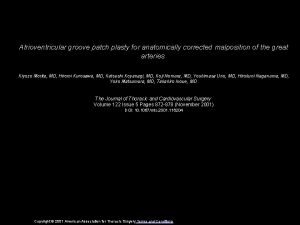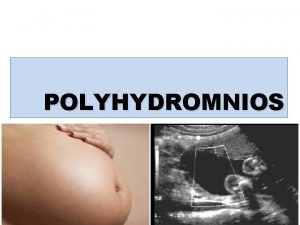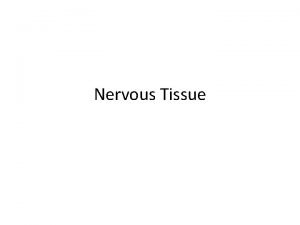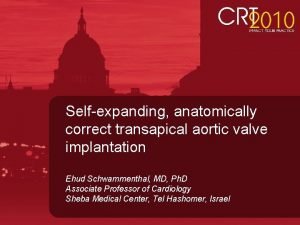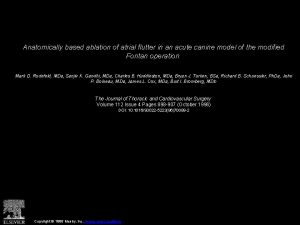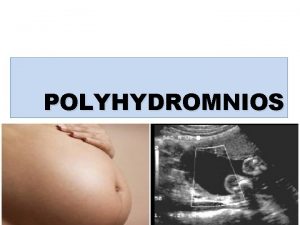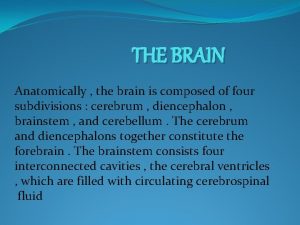Introduction CAD treatment anatomically driven for a halfcentury






















































- Slides: 54


Introduction • CAD treatment - anatomically driven for a half-century • Favored approach for CAD management continues to be fixing all significant coronary stenosis Despite technological advances in both coronary revascularization and nonrevascularization treatment options • OMT Therapeutic lifestyle intervention + aggressive, multifaceted pharmacological secondary prevention

• Sophisticated noninvasive imaging modalities available • Final common diagnostic pathway - coronary angiography obstructive CAD - myocardial revascularization

Angiographically complete Vs incomplete revascularization • Improved long-term outcome after multivessel revascularization for stable CAD in angiographically complete revascularization • Complete revascularization • Not always pursued • Not always achieved

• Residual SYNTAX score (RSS) Øto quantitatively assess the degree and complexity of residual stenoses by recalculating the SYNTAX score (SS) after PCI • SYNTAX revascularization index (SRI) ØQuantification tool to assess the proportion of CAD that has been treated by PCI

functional significance of a lesion • On the basis of FFR • More important determinant of future adverse cardiac events than the angiographic appearance of the lesions • PCI on angiographically significant lesions that are not functionally significant can be deferred safely with good longterm outcomes

Hypothesis • “functionally” complete revascularization with FFR guidance in patients with multivessel CAD, the residual angiographic disease, which is not functionally significant, would not be predictive of outcomes, as assessed by the RSS or SRI

Goal • Investigate the prognostic value of RSS and SRI quantification systems in patients enrolled in the FFR-guided PCI cohort of the FAME (Fractional Flow Reserve Versus Angiography for Multivessel Evaluation) trial, who underwent functionally complete revascularization with FFR guidance

METHODS Superiority • FAME trial ØProspective ØRandomized ØControlled ØMulticenter FFR-guided PCI angiography-guided PCI multivessel CAD

Multivessel CAD amenable to PCI At least 50% diameter stenosis FFR-guided PCI FFR ≤ 0. 80 Treated with PCI Angiography-guided PCI FFR >0. 80 Left untreated All lesions treated

Angiography-guided PCI not included in this study • Not undergo FFR assessment and calculation of the functional SYNTAX score (FSS) • Angiographically complete revascularization in all patients (very little residual stenosis existed after PCI in these patients)

Inclusions in ACS • Patients with STEMI enrolled if the infarction had occurred at least 5 days before PCI • UA or NSTEMI allowed earlier than 5 days if the peak creatinine kinase <1, 000 IU • Patients with prior PCI included

Exclusion • Significant left main CAD • Previous coronary artery bypass surgery • Cardiogenic shock • Extremely tortuous or calcified coronary arteries • Pre- and post-procedural angiogram data not available

FFR MEASUREMENT AND TREATMENT • PCI performed according to standard coronary interventional techniques, primarily with DES • FFR was measured with a 0. 014 -inch pressure sensor guidewire (St. Jude Medical) • After equalization to the guide catheter pressure with the sensor positioned at the ostium of the coronary artery, the pressure guidewire advanced down the target coronary artery

• To induce maximal hyperemia, intravenous adenosine was administered at 140 mg/kg/min through a central vein • Simultaneous measurement of the mean proximal coronary pressure with the guide catheter and the mean distal coronary pressure with the pressure guidewire performed • FFR was calculated as the ratio of the mean distal to proximal coronary pressure at hyperemia • All patients received dual antiplatelet therapy with aspirin and clopidogrel for at least 1 year after PCI

SS pre-procedural angiogram Coronary lesion producing ≥ 50% diameter stenosis in vessels ≥ 1. 5 mm by visual estimation (SS algorithm from the SYNTAX Score website) overall SS The FSS calculated by deducting the individual score of lesions with an FFR >0. 80

RSS For the RSS, a higher value suggests more CAD left untreated after PCI post-procedural angiograms Reviewed by a dedicated interventional cardiologist blinded to the baseline clinical characteristics, procedural data including FFR values, and clinical outcomes obtain the RSS

SRI = 100 – RSS/ baseline SS ( % ) shows the proportion of CAD treated by PCI a lower value suggests more CAD left untreated after PCI. Post-procedural angiograms from 50 patients randomly selected and reanalyzed by the same interventional cardiologist and a second independent interventional cardiologist to assess intraobserver and interobserver variability of the RSS

Representative Cases With the Same SS, But Different FSS, RSS, and SRI Case 1 SS = 16 FSS = 16 RSS = 0 SRI = 100% Case 2 SS = 16 FSS = 8 RSS = 8 SRI = 50%

Primary endpoint Death MACE Myocardial infarction Any repeat revascularization At 1 year after the index procedure among the RSS and SRI subgroups

• Analyses repeated with 2 -year follow-up data • An independent clinical events committee adjudicated all events (members blinded to treatment strategy)

RESULTS

509 FFR-guided PCI cohort of the FAME trial unavailability of a post-procedural angiogram 427 Both pre- and post-procedural angiograms available Patient characteristics, including age, sex, comorbidities Number of lesions intended to be treated similar between included and excluded patients Rate of MACE at 1 and 2 years Higher incidence of unstable angina in the included patients (31. 9% vs. 17. 2%, p < 0. 01)

SCORE SS pre- procedural angiogram post-procedural angiogram 14. 4 7. 2 FSS 10. 8 8. 0 RSS SRI 6. 5 55. 1% 5. 8 32. 5%

integration of functional information into the RSS and SRI should improve the prognostic value


finding that the SRI positively correlated with the FSS explains that the SRI had no prognostic value because the SRI should be negatively correlated with the FSS to be prognostic


COMPARISONS OF BASELINE DATA AMONG THE RSS AND SRI SUBGROUPS • Baseline patient clinical characteristics were similar among the RSS and SRI subgroups • Except for • Diabetes in the RSS and SRI subgroups (p 0. 02 and p 0. 007) • History of myocardial infarction in the SRI subgroups (p 0. 03) • Diabetes was lowest in patients with RSS 0 and SRI 100%, which represents angiographically complete revascularization



With increasing RSS • SS increased • Number of lesions intended to treat increased • FSS did not vary • Total number of stents per patient decreased • Total stented length per patient decreased

with decrement of SRI • The SS, FSS, and number of lesions intended to treat did not vary in a predictable fashion • Total implanted stents per patient • Total stented length per patient • volume of contrast agent Decreased

CLINICAL OUTCOMES • MACE at 1 year occurred in 53 patients (12. 4%) • patients with MACE had higher SS and FSS than patients without MACE • RSS and SRI were similar between patients with and without MACE


• MACE and each component of MACE were not different among the RSS and SRI subgroups at 1 year • Kaplan-Meier curves at 1 year showed no significant separation ØAmong RSS and SRI subgroups ØWhen stable and unstable patients analyzed separately Øwhen patients with SS 0 to 22 and with SS >23 analyzed separately


Kaplan – Meier curves at 1 year showed no significant separation

2 -YEAR CLINICAL OUTCOME DATA • To test the durability of the results with longer-term follow-up • Same analyses repeated with 2 -year outcome data • MACE occurred in 74 patients (17. 3%) at 2 years • Patients with MACE had higher SS and FSS than patients without MACE • RSS and SRI were similar between patients with and without MACE

2 -YEAR CLINICAL OUTCOME DATA • MACE and each component of MACE were not different among the RSS and SRI subgroups at 2 years • Kaplan-Meier curves at 2 year showed no significant separation ØAmong RSS and SRI subgroups ØWhen stable and unstable patients analyzed separately Øwhen patients with SS 0 to 22 and with SS >23 analyzed separately

DISCUSSION - The principal finding of the present study • RSS and the SRI do not predict MACE at 1 - and 2 -year follow-up in patients with multivessel CAD after functionally complete revascularization • Reinforce that an FFR guided PCI strategy offers sufficient revascularization • PCI of angiographically significant, but not functionally significant, lesions can be safely deferred • Raise the question of whether RSS and SRI scores should be applied without accounting for the FFR result of specific lesions

• FSS better stratified the risk of MACE in patients undergoing multivessel FFR-guided PCI (based on previous FAME substudy) • Fact that the RSS correlated significantly with the SS, but not with the FSS, explain why the RSS had no prognostic value after functionally complete revascularization • With each decrement of the RSS, the number of lesions intended for treatment increased but the actual number and length of stents implanted decreased • Patients with an RSS >8 had the highest baseline SS, but received the fewest number and shortest length of stents ( long-term outcome was similar compared with the other subgroups )

• Finding that the SRI positively correlated with the FSS explains that the SRI had no prognostic value because the SRI should be negatively correlated with the FSS to be prognostic • With each decrement of the SRI, the number of lesions indicated tended to increase; however, the actual number/ length of stents implanted decreased, and the long term outcome was similar • Suggest that a scoring system with a purely anatomic approach may be insufficient, not only for the pre-procedural assessment, but also for the post-procedural assessment for predicting outcome after PCI.

• RSS and SRI associated with worse long-term outcomes after angiography guided PCI highlight importance of angiographically complete revascularization in managing patients with stable angina and multivessel CAD • Angiographically complete revascularization is better than angiographically incomplete revascularization • This study supports the concept that functionally complete revascularization is as good as angiographically complete revascularization, if not better

OBSERVATION RSS correlated significantly with the SS, but not with the FSS With decrement of the RSS, the number of lesions intended for treatment increased but the actual number and length of stents implanted decreased INFERENCE RSS had no prognostic value after functionally complete revascularization “ scoring system with a purely anatomic approach may be insufficient, not only “ Patients with an RSS >8 had the highest baseline SS, the pre-procedural assessment, but also for the post-procedural butfor received the fewest number and shortest length of stents assessment for predicting outcome after PCI. SRI positively correlated with the FSS SRI had no prognostic value With decrement of the SRI, the number of lesions indicated tended to increase but the actual number/ length of stents implanted decreased, and the long term outcome was similar “


STUDY LIMITATIONS • May not be applicable for patients with STEMI because patients with STsegment elevation myocardial infarction within 5 days were excluded • Do not have a control arm because all angiographically significant lesions in angiography-guided PCI cohort were treated with PCI • Small proportion of functionally significant lesions may have been left untreated due to the complexity of CAD anatomy, procedural failure, or the operator’s discretion • Because the baseline complexity of CAD is relatively low in this population, results may not apply to patients with more extensive CAD • Study being a post hoc analysis of the FFR-guided PCI arm of the FAME trial, which was not designed to assess the impact of residual lesions or the extent of revascularization after FFR-guided PCI, should be interpreted as hypothesis-generating

Conclusions • After functionally complete revascularization with FFR guidance, the residual functionally insignificant lesions do not increase the risk for MACE • Angiography-based RSS and SRI do not predict a worse long-term outcome in these patients • Supports the concept of functionally complete revascularization, rather than angiographically complete revascularization

Do these findings provide insight into the design and conduct of current trials? • Whether revascularization plus OMT of ischemia-producing disease is superior to OMT alone in a large population of stable CAD patients remains unproven !!! ISCHEMIA

ISCHEMIA trial International Study of Comparative Health Effectiveness with Medical and Invasive Approaches long-term superiority Revascularization of choice plus OMT alone (FFR-guided PCI or CABG surgery) Composite endpoint of cardiovascular death or myocardial infarction In subjects with moderate-to-severe ischemia as assessed by stress studies

FAME-3 trial 3 -vessel CAD FFR-guided PCI with newgeneration DES CABG surgery Directly test physiologically versus anatomically directed revascularization

• Until these ongoing studies conclude, clinicians will need to make individual revascularization decisions based on currently available trials data

Present analysis adds to scientific evidence • Physiologically directed PCI approach to identifying and treating only functionally significant coronary stenoses ØLead to better clinical outcomes ØDefines a path forward to utilize PCI in a more selective, safe, and cost-effective manner

THANK YOU
 Fovea palatini
Fovea palatini Introduction to cad
Introduction to cad Kontinuitetshantering i praktiken
Kontinuitetshantering i praktiken Typiska drag för en novell
Typiska drag för en novell Tack för att ni lyssnade bild
Tack för att ni lyssnade bild Returpilarna
Returpilarna Shingelfrisyren
Shingelfrisyren En lathund för arbete med kontinuitetshantering
En lathund för arbete med kontinuitetshantering Personalliggare bygg undantag
Personalliggare bygg undantag Tidbok för yrkesförare
Tidbok för yrkesförare Anatomi organ reproduksi
Anatomi organ reproduksi Vad är densitet
Vad är densitet Datorkunskap för nybörjare
Datorkunskap för nybörjare Tack för att ni lyssnade bild
Tack för att ni lyssnade bild Hur skriver man en debattartikel
Hur skriver man en debattartikel Delegerande ledarstil
Delegerande ledarstil Nyckelkompetenser för livslångt lärande
Nyckelkompetenser för livslångt lärande Påbyggnader för flakfordon
Påbyggnader för flakfordon Lufttryck formel
Lufttryck formel Publik sektor
Publik sektor Jag har nigit för nymånens skära
Jag har nigit för nymånens skära Presentera för publik crossboss
Presentera för publik crossboss Argument för teckenspråk som minoritetsspråk
Argument för teckenspråk som minoritetsspråk Plats för toran ark
Plats för toran ark Klassificeringsstruktur för kommunala verksamheter
Klassificeringsstruktur för kommunala verksamheter Epiteltyper
Epiteltyper Bästa kameran för astrofoto
Bästa kameran för astrofoto Cks
Cks Byggprocessen steg för steg
Byggprocessen steg för steg Mat för unga idrottare
Mat för unga idrottare Verktyg för automatisering av utbetalningar
Verktyg för automatisering av utbetalningar Rutin för avvikelsehantering
Rutin för avvikelsehantering Smärtskolan kunskap för livet
Smärtskolan kunskap för livet Ministerstyre för och nackdelar
Ministerstyre för och nackdelar Tack för att ni har lyssnat
Tack för att ni har lyssnat Referat mall
Referat mall Redogör för vad psykologi är
Redogör för vad psykologi är Borstål, egenskaper
Borstål, egenskaper Tack för att ni har lyssnat
Tack för att ni har lyssnat Borra hål för knoppar
Borra hål för knoppar Orubbliga rättigheter
Orubbliga rättigheter Formel standardavvikelse
Formel standardavvikelse Tack för att ni har lyssnat
Tack för att ni har lyssnat Steg för steg rita
Steg för steg rita Vad är verksamhetsanalys
Vad är verksamhetsanalys Tobinskatten för och nackdelar
Tobinskatten för och nackdelar Toppslätskivling dos
Toppslätskivling dos Modell för handledningsprocess
Modell för handledningsprocess Egg för emanuel
Egg för emanuel Elektronik för barn
Elektronik för barn Plagg i gamla rom
Plagg i gamla rom Strategi för svensk viltförvaltning
Strategi för svensk viltförvaltning Var 1721 för stormaktssverige
Var 1721 för stormaktssverige Indikation för kejsarsnitt på moderns önskan
Indikation för kejsarsnitt på moderns önskan Sju för caesar
Sju för caesar
